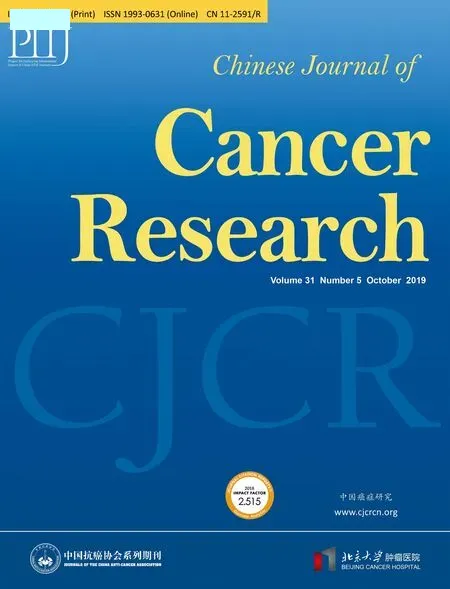Comments on Chinese guidelines for diagnosis and treatment of melanoma 2018(English version)
Xue Bai,Lili Mao,Jun Guo
Key Laboratory of Carcinogenesis and Translational Research(Ministry of Education/Beijing),Department of Renal Cancer and Melanoma,Peking University Cancer Hospital &Institute,Beijing 100142,China
Melanoma is a rare malignant tumor in China;however,its mortality rate is high and the incidence rate is also increasing year by year.In order to improve the efficacy of melanoma treatment,the National Health Commission of the People’s Republic of China revised Chinese guidelines for diagnosis and treatment of melanoma in 2018,and meanwhile its modified English versionChinese guidelines for diagnosis and treatment of melanoma 2018(English version)(1)is also published.Based on the most updated research findings for the Chinese ethnicity with emphasis on acral and mucosal melanomas,two most commonly seen subtypes in Asia,as well as treatment for melanoma liver metastases.The guideline,with its well-organized structure,concisely-written sentences and easily understandable language,helps medical staffs and patients from other parts of the world understand better what our extensive experience is in terms of treating melanoma subtypes that are rarely seen in the Caucasian population.
In overview,it shows the epidemiological characteristics of melanoma in Chinese population.Although relatively rarely seen in China,the incidence of melanoma is keeping climbing in the past a few years,and its death rate is substantially high.Great differences have been well appreciated comparing melanoma in China and its western counterparts,regarding underlying genetic etiological mechanisms,biological behavior,pathological morphology,therapeutic modalities,and prognoses,etc.To be more specific,in Asian and other populations with easily tanned skin types,the prevalent subtype is acral melanoma(approximately 50% in China),with primary lesions most commonly seen in palm,sole,toes,fingers,and nail beds;followed by mucosal subtype(20%-30%)prevailingly originated from rectus,anus,valva,eyes,nasal and oral cavity,etc.On the contrary,in Caucasian population,more than 90% of melanoma is cutaneous melanoma,most commonly seen in trunk and lower limbs;acral and mucosal melanoma,as reported before,comprised of only approximately 1%-5% of the whole melanoma populations.
The diagnosis part focuses on both pathological and radiological diagnostic criteria.As is well known,pathological diagnosis is the gold standard and is essentially required if there is any sign suggesting a diagnosis towards melanoma.It is a great challenge for the early diagnosis of melanoma in China,as this particular disease is rarely seen and less commonly known,and also as acral and mucosal subtypes prevail,which are more clinically occult compared with their cutaneous counterpart.It is suggested that caution should be raised if there is giant nevus and/or unhealed wound seen at the extremities.Of note,the wellknown ABCDE principle is only serving for the purpose of rough screening to tell if a nevus is suspicious or not in terms of malignancy and whether further pathological evaluation is required.Melanoma diagnosis should not be based solely on naked eye observations.Guidelines from western countries,including National Comprehensive Cancer Network(NCCN)guidelines,primarily focus on the pathological diagnosis criteria for cutaneous melanoma,which are totally understandable based on the melanoma subtype distribution pattern in Caucasian populations.It renders mucosal melanoma in need of a standardized pathological diagnostic criterion.It is highlighted in this guideline that the pathological characteristics of mucosal melanoma can be generally phrased as infiltrative lesions with and/or without Paget like spreading.Melanoma cells can be in the appearance of epitheloid,spindle,plasmacytoid,ballooning change,etc.with and/or without pigmentation.Immunohistochemistry staining for melanoma lineage-specific markers is usually required.The main purpose for radiological diagnosis is to determine if there is regional lymph node involvement and/or distant metastasis.So far,positron emission tomographycomputed tomography(PET-CT),CT,magnetic resonance imaging(MRI)are the mainstay tools for radiological evaluation.
Different staging systems exist for melanoma.This is based on the fact that melanoma can be originated from cutaneous and/or mucosal melanocyte located anywhere anatomically,and melanomas with different origins tend to be of different prognosis.Based on the rarity of certain melanoma subtypes,e.g.acral and mucosal melanoma,in Caucasian population,which renders statistical underpowered for the establishment of a definitive staging system,it is not surprising that exploration and further validation of subtype-specific staging system is still in need.So far,we follow the stating criteria of the 8th version of American Joint Committee on Cancer(AJCC)for both cutaneous and ocular melanomas,and the pTNM staging criteria of cervix cancer and meningeal malignancy for melanomas in cervix and meminges,respectively.There is no pTNM staging system for melanomas in digestive tract(including esophagus,small intestine,and bowel melanomas)and vagina,but we recommended to describe stratum with melanoma cell infiltration in the pathological report.
Multiple disciplinary treatments including surgery,radiotherapy,and systemic treatment(chemotherapy,targeted and immunotherapy)are the primary method for melanoma therapeutics.The target number of lymph node resected is specifically described in this guideline for lymph node dissection.Besides,different therapeutic recommendations are provided for metastases in different organs involved,e.g.brain,liver,bone,and intransit lesions.Since the most prevalent subtype in China is acral melanoma,based on our research findings,high-dose interferon is still recommended in the adjuvant setting.For patients with metastatic melanoma,as different drugs are being approved by CFDA with accelerated rates and with large amount of emerging clinical trials,we are confident that melanoma patients in China will benefit tremendously.This guideline focuses more on previously less described subtypes(acral and mucosal melanoma),as well as liver metastasis.
In short,the revised English version of melanoma guideline will contribute to international communication between melanoma communities in China and overseas,and promote development of melanoma therapeutics.
Acknowledgements
None.
Footnote
Conflicts of Interest:The authors have no conflicts of interest to declare.
 Chinese Journal of Cancer Research2019年5期
Chinese Journal of Cancer Research2019年5期
- Chinese Journal of Cancer Research的其它文章
- A study on service capacity of primary medical and health institutions for cervical cancer screening in urban and rural areas in China
- Medical expenditures for colorectal cancer diagnosis and treatment:A 10-year high-level-hospital-based multicenter retrospective survey in China,2002-2011
- Surgical outcomes of hand-assisted laparoscopic liver resection vs.open liver resection:A retrospective propensity scorematched cohort study
- Texture analysis on gadoxetic acid enhanced-MRI for predicting Ki-67 status in hepatocellular carcinoma:A prospective study
- Machine-learning-assisted prediction of surgical outcomes in patients undergoing gastrectomy
- Prognostic significance of lymphovascular infiltration in overall survival of gastric cancer patients after surgery with curative intent
